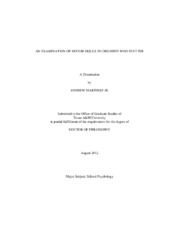| dc.description.abstract | Recently, research has postulated that stuttering is a motor disorder that results from brain abnormalities within the central nervous system. Based on evidence of numerous irregularities within various motor systems, it has been suggested that other motor domains may be comprised. In particular, research in individuals who stutter has found fine, gross, and visual-spatial motor impairment. These studies, though, are dated, have numerous methodological concerns, or yielded contradictory results. Thus, this study investigated whether motor skills in children who stutter (CWS) were compromised. Fine motor skills are important in a school environment because students are required to utilize these skills to complete various assignments and projects, such as cutting and folding paper. Gross motor skills are equally as important as children use these skills to move around their environment. Visual-spatial motor skills are vital for children as they are often required to copy notes off of the board. Deficits in any of these areas may have potentially harmful effects on school performance. Thus, in a school setting, school psychologists are a valuable asset, as they are trained to consult and work with "at risk" populations to prevent long-term problems. Given the potential motor deficits in CWS, school psychologists can intervene and provide appropriate accommodations to remediate any motor deficits.
Participants included 12 CWS and 12 children who do not stutter (CWNS). Participants were recruited from a large urban school district and were administered the Bruininks-Oseretsky Test of Motor Proficiency-Second Edition (Bruininks & Bruininks, 2005; BOT-2). Parents completed a demographic questionnaire. One Way Analyses of Variance (ANOVAs) were calculated to compare group means. Results indicated that CWS performed poorer on all but one motor area. Given these results, when a child is identified with a disfluency problem, a broader consideration of issues that may be facing the child is warranted. In particular, school psychologists are in a position to intervene and provide appropriate services to an "at risk" population (i.e., CWS) by conducting a brief motor assessment to identify motor strengths and weaknesses. If warranted, school psychologists can provide accommodations and services to address any identified weaknesses in motor areas. | en |


